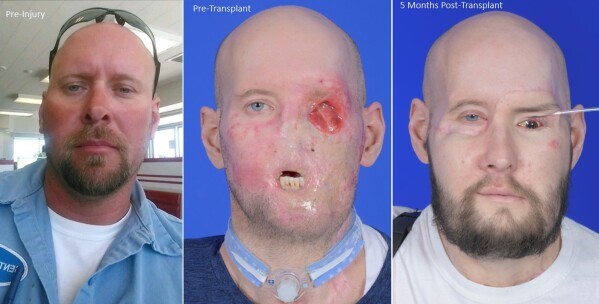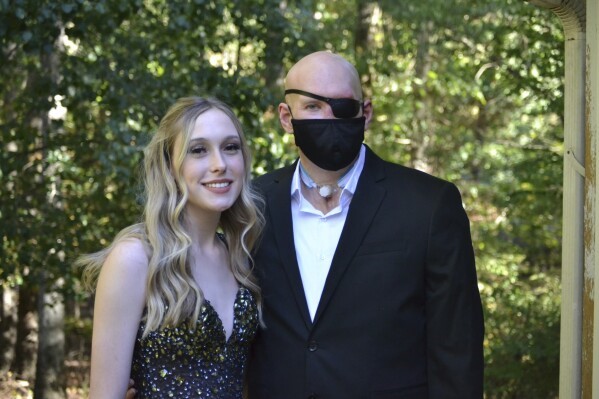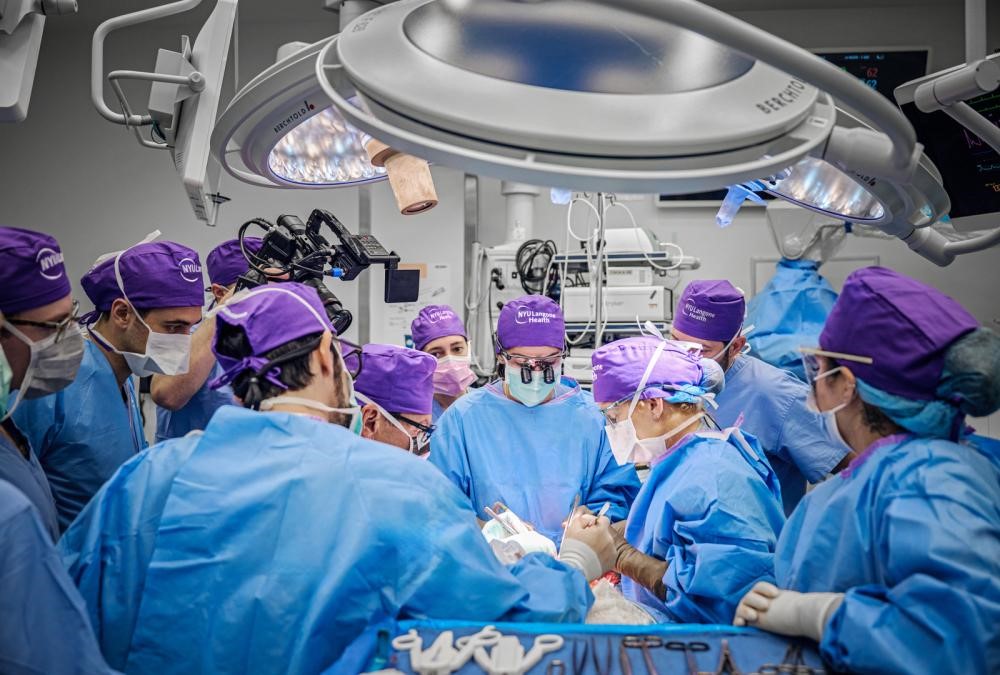NOTE: The following article contains content that some might find disturbing. Please read at your own discretion.

Surgeons in New York believe they may be one step closer to curing blindness after an Arkansas man became the first known patient to successfully receive a complete eye transplant in May.
NYU Langone Health announced the accomplishment on Thursday. Representatives for the academic medical centre said 46-year-old military veteran Aaron James received a donated eye — and donated optic nerve — and underwent a rare partial face transplant.
James, a former lineman, was injured in June 2021 after surviving a workplace accident involving high-voltage power lines. The 7,200-volt electric shock caused James to lose his left eye and much of his face.
James’ right eye is still functioning.
Less than two years after his injury, James became the first person in known medical history to ever successfully undergo a whole-eye transplant, though he does not have sight through the donated eye.
It is unclear if he will ever regain his sight in the new eye, though James told The Associated Press he has regained some sensation in the region since the surgery.
“The transplanted left eye has shown remarkable signs of health, including direct blood flow to the retina — the area at the back of the eye that receives light and sends images to the brain,” Langone Health wrote in a statement.
The surgery took 21 hours and replaced half of James’ face.
More than 140 healthcare professionals were involved in the procedure.
“This achievement demonstrates our capacity to embrace the most difficult challenges and drive continuous advancements in the field of transplantation and beyond,” said Dr. Eduardo D. Rodriguez, who led the surgery.
“The mere fact that we’ve accomplished the first successful whole-eye transplant with a face is a tremendous feat many have long thought was not possible,” he continued. “We’ve made one major step forward and have paved the way for the next chapter to restore vision.”
Following James’ workplace accident, he was forced to lose his left eye after it began causing him severe pain. James also lost his dominant left arm from above the elbow, his entire nose and lips, front upper teeth, and left cheek area as well as his chin down to the bone.
With James’ eye specifically, Rodriguez and his team of surgeons cut the patient’s optic nerve as close to the eyeball as possible in the hopes of potential transplant.
Though corneal transplants are fairly common, whole-eye transplants are very complex and pose a number of challenges surrounding regeneration, immune rejection and retinal blood flow.
James and his medical team eventually decided to move forward with a whole-eye transplant in combination with the face transplant, though the risky surgeries were likely to only provide cosmetic benefits. To restore a patient’s vision, surgeons would have to reconnect the optic nerve to a patient’s brain. James’ doctors felt, whether functional or not, the donated eye would better support the facial transplant and provide cosmetic benefits around patient’s eye socket and lid.

Within three months, a potential donor was identified.
The donor, a man in his 30s, reportedly “came from a family that strongly supports organ donation.” His donated tissues were used in James’ surgeries, but also saved three other lives using the donor’s kidneys, liver and pancreas, according to Langone Health.
In the hopes of improving the likelihood of nerve regeneration in the donated eye, James’ surgical team injected the donated hazel eye with adult stem cells derived from the donor’s bone marrow. Doctors now hope the cells will divide and create more healthy cells that can replace damaged or dysfunctional nerves.
This was also the first known instance of injecting adult stem cells into a human optic nerve during a transplant.
For James’ facial transplant, medical professionals used state-of-the-art technology and three-dimensional computer surgical planning to optimize their approach. After meticulous planning, surgeons were able to fit the eye and grafted partial face onto James.
As of now, James can’t yet open the new eyelid and wears an eyepatch to protect it.

Throughout his surgical procedures, James also underwent an intensive immunosuppression regimen to prevent rejection of the donated cells.
He spent 17 days in the intensive care unit (ICU) before he was discharged on July 6. From home, James continued physical, occupational and speech therapy.
“I’m grateful beyond words for the donor and his family, who have given me a second chance at life during their own time of great difficulty. I hope the family finds solace in knowing that part of the donor lives on with me,” James said. “I will also forever be thankful to Dr. Rodriguez and his team for changing my life. My family and I wouldn’t have been able to navigate this difficult journey without their expertise and support. Our hope is that my story can serve as inspiration for those facing severe facial and ocular injuries.”
In the coming months, James plans to undergo orthodontic treatment and dental rehabilitation. But for now, James said he is looking forward to Thanksgiving in the U.S. — the first holiday meal he said he will be able to eat since his injury.
Surgeons and academics are calling James’ case a leap forward in the quest to cure blindness. Though science is still a long way away from fully restoring sight to patients, medical professionals are hoping James’ “groundbreaking” whole eye transplant will open the door for a myriad of other scientific breakthroughs.
- ‘Hiroshima-level casualties’ feared in final battle for North Darfur
- Canada to donate $3M to Ukraine drone production, buy more ammunition
- Canada is unblocking aid to Afghanistan but delay is ‘extremely frustrating’: advocate
- Harvey Weinstein hospitalized after return to jail following rape conviction overturn





Comments